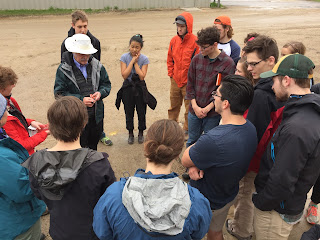This spring, I am taking a quick detour from New England phenology to teach a Population Ecology course at Carleton College in Northfield, Minnesota. Last week was very exciting around here, because we had several special visitors: Pam Templer, Sam Roberts, and Dan and Erika Tallman!
On Monday (4/10) Pam Templer visited from Boston University to meet with students, tour the ecosystem ecology experiments in Carleton’s Cowling Arboretum, and to talk about her research as part of the weekly Biology Seminar Series. Pam gave a great seminar on the effects of winter climate change on N and C cycling, tree growth, and insect diversity in Northeast forests! Her talk was very well received, and students and faculty were all particularly interested in implications for the sugar maple industry.
Pam Templer with her Carleton host, Dan Hernandez
On Friday (4/14) Sam Roberts gave a talk to our Population Ecology class on his master’s research, using bird banding and nest searching data to measure demographic information of Saltmarsh and Seaside Sparrows in New Jersey, and using that information to model the population viability of those species over the next 50 years. He included many great photos and videos of his field methods.
A video Sam Roberts took in the salt marsh, showing the difficulty of finding nests!
Sam and the Pop Eco students talked through potential management strategies, like predator management programs, and he showed some examples of how to incorporate management scenarios into population models. This was a great application of the population growth models we've been using in class.
Later that afternoon, the students got to see bird banding in action! Dan and Erika Tallman visited the Cowling Arboretum to demonstrate and discuss the bird banding process.
Dan Tallman bands a chickadee captured behind the Arboretum offices
In an hour and a half, we caught 16 Black-capped Chickadees, 3 Dark-eyed Juncos, 1 Downy Woodpecker, 3 House Finches, and 1 Red-bellied Woodpecker. The students learned about ageing and sexing birds, and even got to release them!
A Carleton student releases a chickadee!






